What is MarTech and how to organize your Marketing stack
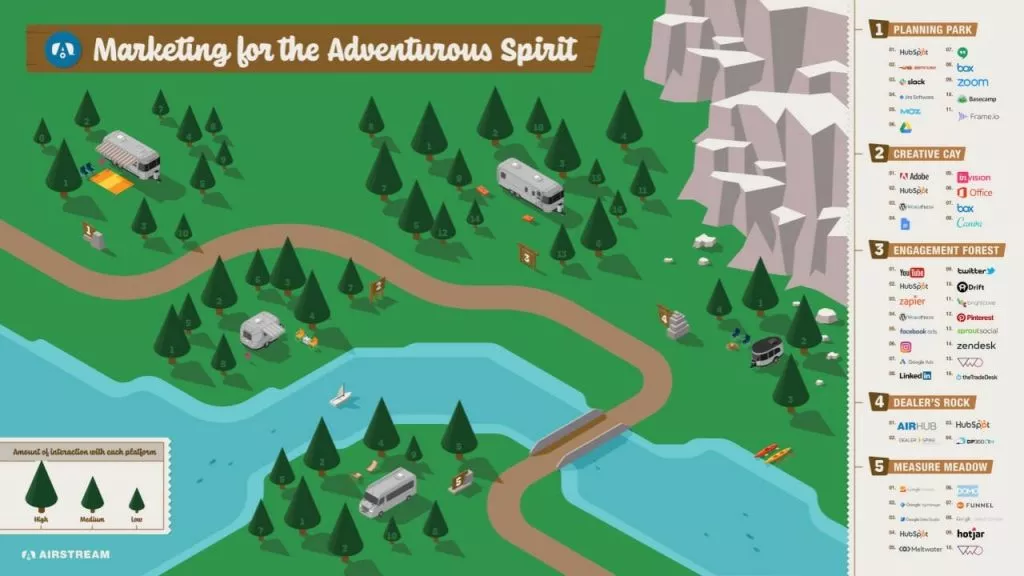
Social Networks, Internet, Smartphone, Whatsapp and all the technologies that have emerged in recent years have become vital in our lives.
Given this, how can companies become TRULY relevant in a time of scarcity of attention?
The path that many took was:
- Understand how to communicate through these new channels;
- Adapt Formats and tone of this “new” communication;
- Create Tools/software to save monitor, interact, automate and protect conversations within these new environments.
As the consumer is increasingly digital, it is impossible to talk about Marketing without talking about Technology.
It was from this mixture that the term MarTech emerged, which is the intersection of these two major areas (marketing and technology).
But what is MarTech?
According to Scott Brinker of chiefmartec.com and one of the main leaders in the sector:
MarTech are the initiatives, efforts and tools that use technology to achieve Marketing objectives.
Scott Brinker
However, the concept goes far beyond simply technology and software.
MarTech's growth is as fast as our personal adoption of new technologies. In 2011 there were 150 Marketing and Sales software and in 2020 more than 8 thousand.
Understanding the universe of tools for marketing and sales is no longer just a trend or fad to become a vital part of Marketing's day-to-day.
An example of MarTech in practice
If you and I are in the same physical store, all ads and promotional content will be the same, prices, discount posters, sales pitches, in a physical store we will see everything exactly the same. All content in a physical store is created for the masses, for the average (average) of interests, in the products that sell more.
In the digital world, this happens differently, with personalization and marketing automation, the experience is customized according to our profile.
The ads and all the stimulus will be based on our characteristics, this is one of the goals of MarTech and marketing automation, to be relevant in scale (example extracted from the book Hacking Marketing).
To reach this level of personalization mentioned, it is essential that marketing is fluent in technology.
The invasion of software in all areas of the company
This software adoption movement is not exclusive to marketing. The other departments such as HR, Support, Operation and others, are also growing the number of solutions.
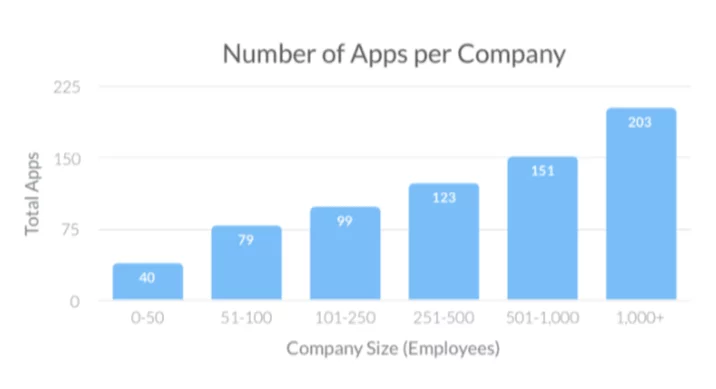
A proof of this is the survey above Blissfully with the average number of software that a company uses according to the number of employees.
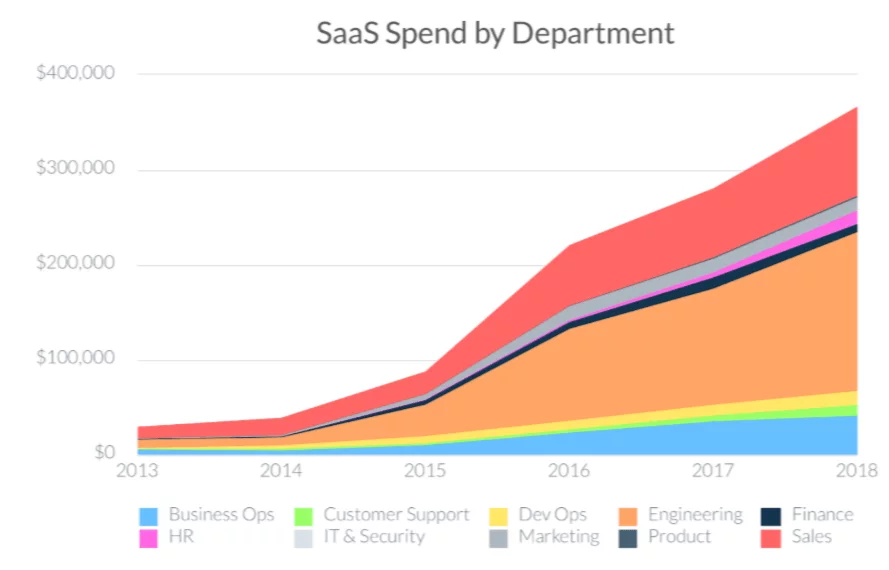
Another data that confirms the adoption of software by the entire company is the image above, which shows the growth in the adoption of software in all areas of the companies, not only in marketing and sales.
MarTech Tool Map
As we are interested in marketing and sales, we will zoom in on our category.
See table below with a map with more than 8 thousand marketing and sales tools separated by category:
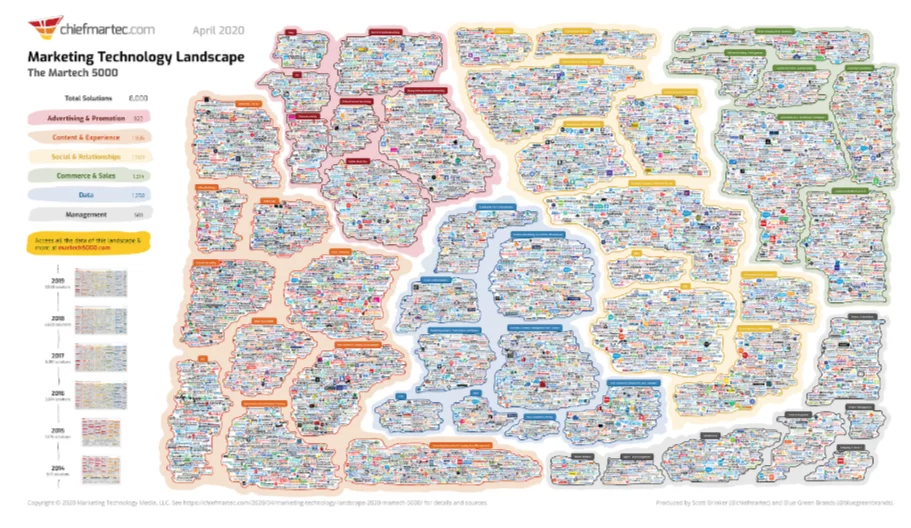
As you can see in the map above, there are so many marketing and sales solutions that they are distributed in about 50 categories, some of them: SEO, Social, Media, CMS, Chat, Media, CRM, Marketing Automation, Content and Ecommerce.
I confess that this tool map causes a mix of joy and anxiety.
With joy because at each launch I like to check if there is a new category or if an existing category has been broken up or incorporated.
The reorganization of the categories in this tool map is a sign of how the market has separated marketing needs.
Demetrio
And the anxiety I feel when I see this map is because I realize that I am losing a lot of interesting software, since it is humanly impossible to test all the tools.
I'm glad some sites help 🙂
Sites that evaluate MarTech software
In order to facilitate the research, qualification and evaluation of software for Marketing and Sales, websites have emerged that make our lives a little easier.
Sites Like:
https://www.trustradius.com/
https://www.g2.com/
https://www.capterra.com.br/
https://martechbase.com/
https://www.kmaleon.com.br/ (Brazilian one)
These sites store much of the Marketing and Sales software where you can search, compare, read other reviews and save your favorite solutions to lists.
Marketing needs to understand software simply because all of our customers are on Digital and secondly because to monitor, publish, interact, automate and protect online conversations we need software.
Regardless of what your Marketing department was or is like, more focused on offline activities such as events, creation of graphic materials or marketing management, the important thing is that in all scenarios, Marketing has incorporated new responsibilities.
Interview with Guto Oliveira founder of the Kmaleon
First of all congratulations on the initiative in the development of the website https://www.kmaleon.com.br/ and thank you for taking the time for this interview.
We have always had the need here in Brazil, for a site like Capterra for example that had a listing, classification and comparison of national tools.
1) What problem does Kmaleon help solve?
Guto Oliveira: Today the process of searching and choosing technologies involves many steps and there is not a very “linear” path that provides security for the user.
In many communities, you sometimes come across someone asking something like: “I need a tool to [solve a certain problem]. Which platform do you recommend? ”.
Kmaleon's main objective is to capture reviews from real customers of each technology on the market and make them available publicly and free of charge.
Each assessment is based on 5 pillars to define the quality of each tool, namely: Usability, Support, Quality, Recommendation (NPS) and Functionalities.
The scores attributed to each of these pillars constitute the Score Kmaleon, a score of excellence for each software.
Within Kmaleon, the user can search, compare each tool side by side to understand what each offers a benefit in relation to the other, but based on the opinions of their respective customers. Therefore, we facilitate the choice for people based on the recommendations of other professionals with similar scenarios.
2) How to align short and long term planning in adopting tools?
Guto Oliveira: First, it is necessary to analyze what is the current scenario of each one. What are the short, medium and long term goals, what are the goals for each period and how much the company can invest in each period to achieve each goal.
Based on the strategies for each scenario designed, the search for tools makes sense. Otherwise you may end up opting for a “basque to kill ants” or the opposite, the chosen tools may not meet the demands of the project.
Bearing in mind what are the goals and strategies based on data aligned to the deadlines, is that you can define what are the essential features for the success of the project. Be it short term or long term.
To manage this flood of Software, marketing is changing its governance
With this technological explosion, marketing needs to manage dozens and dozens of software, control who accesses, manage the validity of SaaS supplier contracts, compare solutions with technical content and the main one, adopt governance practices that were not their responsibility before.
Many of the activities incorporated by Marketing were carried out exclusively by IT, such as:
- Data Governance,
- Control over Transparency and Privacy,
- Taxonomy,
- Agile Management,
- User management,
- Software contract management.
These are some of the activities that are now – in many companies – in the lap of Marketing.
In this technological universe that Marketing is involved in, it has become vital to explore new skills, such as Governance, so that the results of your campaigns are more effective.
Such is the change in Marketing that many companies are even abandoning the traditional position of CMO (Chief Marketing Officer), companies like Johnson & Johnson, Uber, Lyft, Taco Bell and Hyatt Hotels have already announced new positions to fill this space.
With the new responsibilities of Marketing, new positions emerged as “chief growth officer,” “chief experience officer,” “chief commercial officer,” “chief brand officer”, “chief digital” and “chief marketing technologist”.
Historically, Marketing was about Outbound, our goal was to tell customers who we are and what we stand for. Now, it all comes down to having a conversation with the customer. That's why these jobs are changing, because the way companies are marketing has become a balance between left brain and right brain. It's not just about creating creatives anymore.
Evan Sharp da empresa de recrutamento Russell Reynolds Associates.
MCDonald’s is another good example of this change. The position of CMO was dissolved and one of the vacancies created was that of Head of Marketing Technologist.
The responsibilities of the MarTech professional
Among all the new activities of the marketer is what some call a marketing technologist. One who has knowledge of marketing and technology. The research below shows the most common responsibilities of this professional:
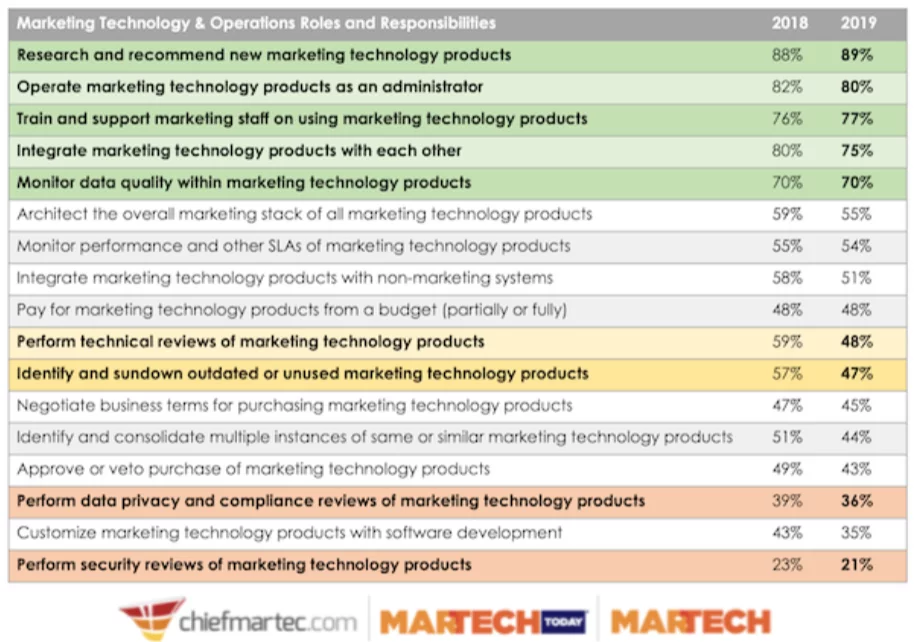
How to organize the software or stack used by marketing and sales
With this flood of software, marketing began to be charged to show everyone in the organization what each tool does and also what stage of the customer's journey each software is responsible for.
These documents that explain the marketing stack – which are the software used by marketing – have become essential and some even very creative, to the point that there is even a contest of the most effective and creative format to explain this mess of software, see some below:
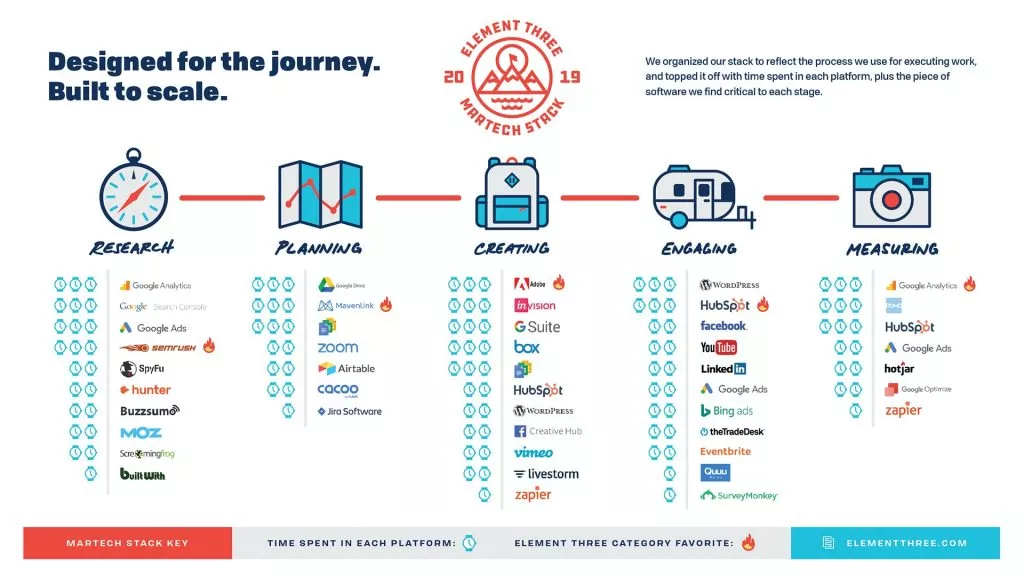
The stackie above AirStream – manufacturer of those retro trailers that I am a fan of – is very simple to understand and also shows the level of use / intensity of each tool within the process.
Airstream marketing is worth mentioning separately, they excel each year, see how they represented the last stackie, put the whole spirit of the brand intertwined in their material, putz, I got to sweat for the eyes with this example.

There are options that need to put fru-fru aside to be objective and concise, as is the case with the next example.
INFORMATICA's next stackie is the answer to the concern of many, how to visualize the path that the data takes inside the stack, very important in times of LGPD (General Data Protection Law).
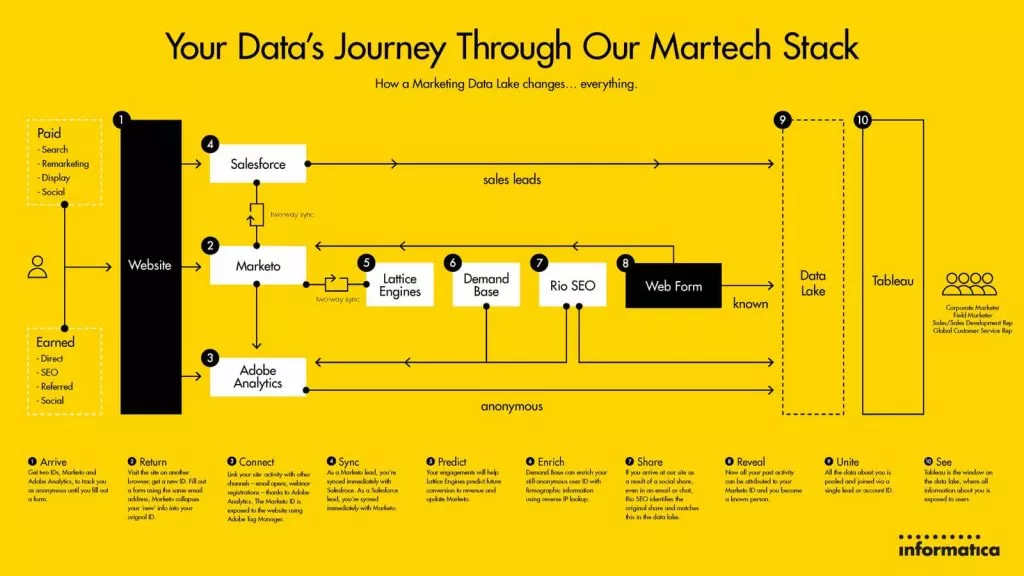
Another interesting point of the stackie above is that it basically represents the stack of many people see:
- CRM (Salesforce)
- Marketing Automation (Marketo)
- Analytics (Adobe Analytics)
- Data Lake to save everything
- BI Dashboard (Tableau)
See how our stack, Powertic's is similar to INFORMATICA's and is probably similar to yours too:
- CRM (Hubspot free)
- Marketing Automation (Mautic)
- Analytics (Google Analytics)
- Data Lake to save everything (same MySQL)
- BI Dashboard (Metabase)
Another point that I find interesting is the flow format, it reminds me a lot of the UML Sequence Diagram or the popular user flow. It is important to study these diagram formats in order to base our diagrams within universal standards.
The next PAYCHEX stackie shows the level of automation of each tool, whether it is fully automated or whether it needs human interaction.
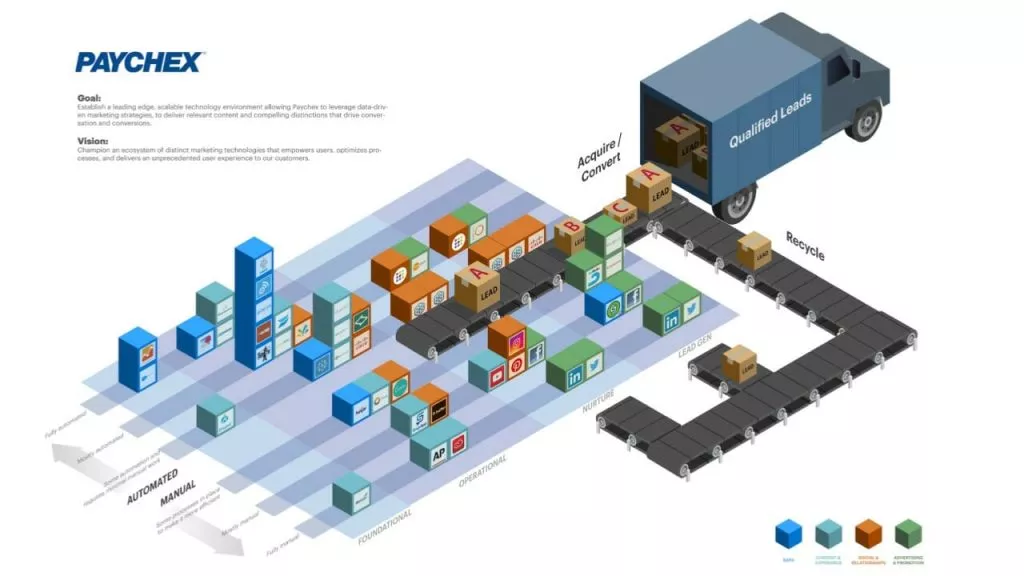
See the zoom below as they show the frequency of use of each software.
A very nice approach because managing a large number of software and budget generates anxiety in the Marketing manager if he is managing to get the most out of his entire stack. With this representation, the manager can be more relaxed, since many of them work on autopilot.
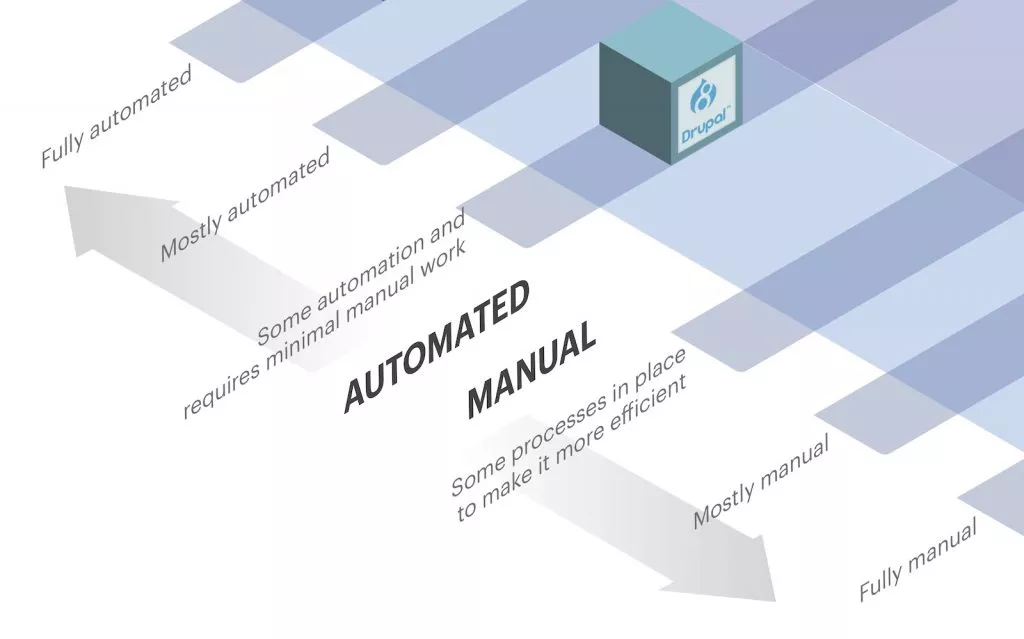
How much should we spend on MarTech?
Every year Gartner conducts a survey on the budget allocated in MarTech in companies, in the last few years it has been around 25% of the budget, see below:

Conclusion
It is noticeable that the planning, adoption and generation of results in this MarTech universe is far from being just the choice of software.
Companies that are successful in adopting MarTech have created and internalized good practices that allow this Technological Marketing to achieve goals consistently and predictably.



Responses